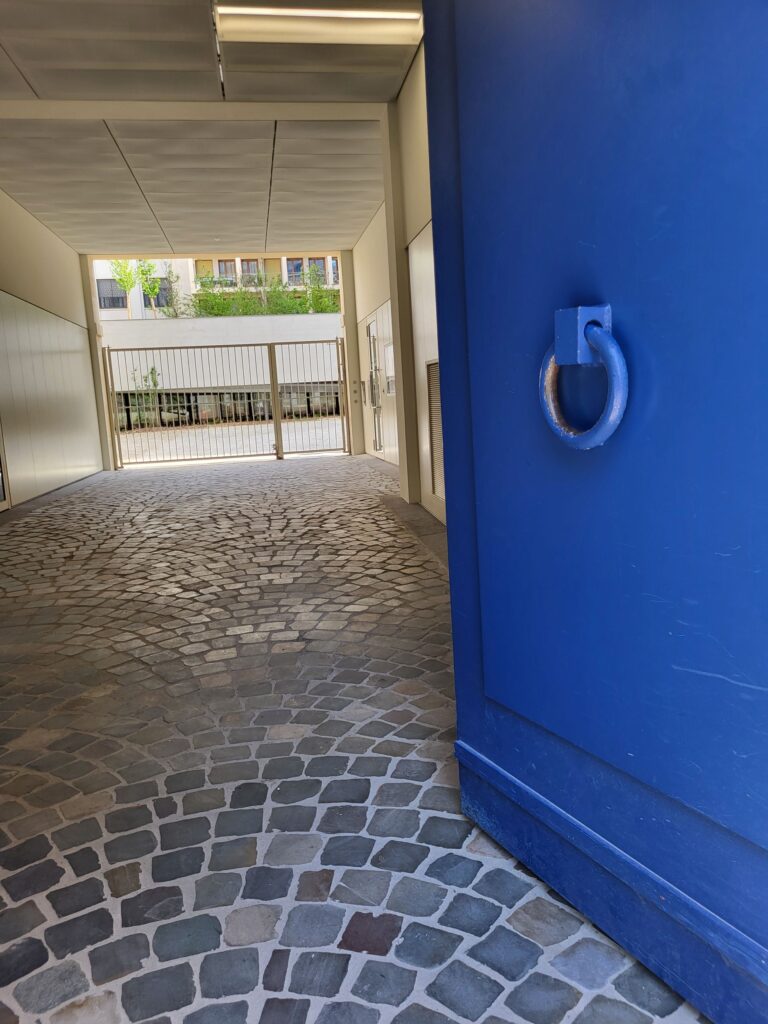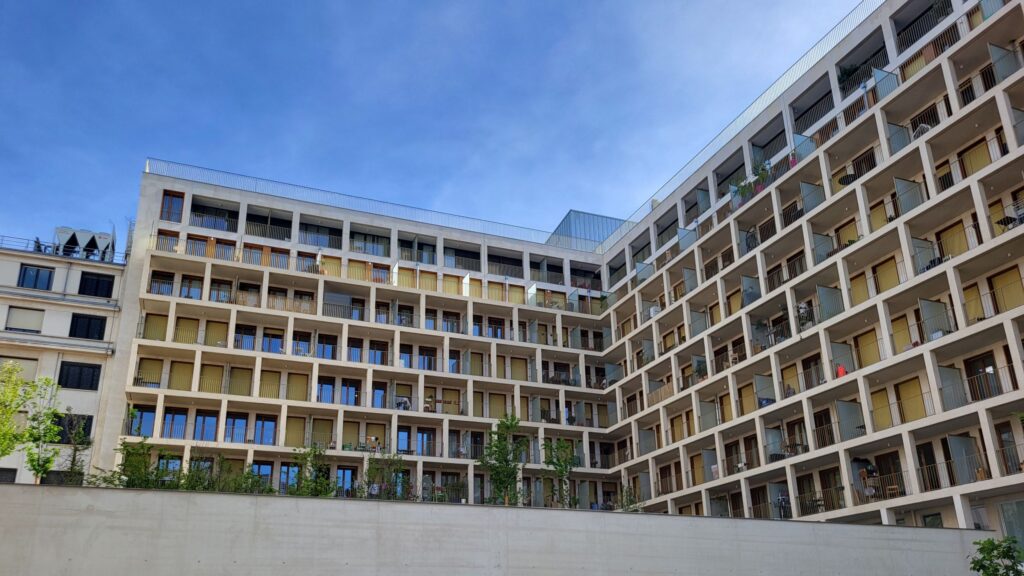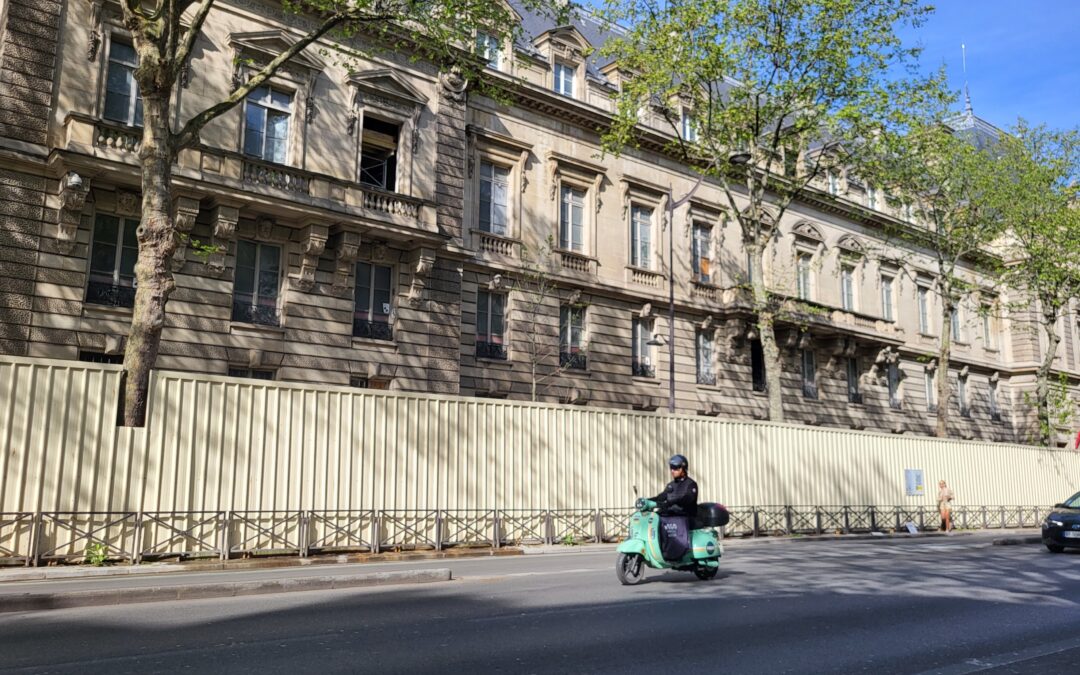The façade of the Defense Ministry building on the Boulevard Saint Germain bears the holes and pockmarks of German bombing in 1918. It’s one of many reminders that wars have time and again been fought in France’s capital city.

Photo: Mary Fleming
The ministry moved to a modern complex in southern Paris in 2015. And now, the enormous site in the 7th arrondissement—it takes up an entire block—is part of what one writer calls “the battle for the future of Paris.”
Bear in mind that the quartier is one of the poshest in the city. So it’s not surprising that the portion of the site that faces the boulevard will become a luxury hotel. Will the bomb damage will be allowed to remain? So far the construction is only visible from the south side.

The developer is Constellation Hotels, owned by the Qatar Investment Authority, and the hotel, on a site of 300,000 square feet, is set to open next year.
In the interior of this sprawling complex, though, is a residence that’s already open and occupied—by public-housing residents. It was a condition set by the city of Paris, run by Socialist Mayor Anne Hidalgo, for approving the hotel deal. You can see it only through a gate to the courtyard, unless you luck out and someone buzzes you in.

This video, filmed at the grand opening last fall, gives a good idea of the look and layout of the apartments. They range from 300 square feet to 800 square feet.

It turns out that “mixité” (mixing) is a longstanding tenet of City Hall’s public-housing programs, both in terms of building social housing in well-off parts of the city and in allowing middle-income residents to get subsidized apartments.
Paris is also more mixed than many other cities in terms of space use: A typical version of those cream-colored stone buildings can easily contain retail space on the ground floor, offices on the next floor up, spacious apartments on the subsequent floors and tiny garrets, formerly maids’ rooms, on the top floor.
When the Defense Ministry project is done, the neighborhood will be a blend of public-housing residents, longtime Left Bank dwellers and well-heeled hotel guests from near and far.
There has been some political controversy over it, fueled especially by Rachida Dati, the rightist mayor of the 7th arrondissement. But the biggest concern raised by neighbors so far is construction noise and other inconveniences, my friend Mary Fleming, who lives across the street from the project, explains in a blog post about it.
A law passed in 2000 requires municipalities to reach a 25% target for affordable housing by this year. In a country as centralized as France, NIMBYism can’t get very far given that kind of pressure.

To better understand mixité, I turned to Cole Stanger. His “Paris Is Not Dead: Surviving Hypergentrification in the City of Light,” is a lucid and thoroughly researched explanation of how the working class, a driving force in Paris history (think the 1789 Revolution and many uprisings that followed), is now being forced from the city by high rents. And how Paris over the years has responded.
He decided to write it, he explained, because he was living in northeast Paris in a vibrant ethnic neighborhood rarely seen by tourists—or many Parisians. In the book, he calls it “the front lines for the battle over the future of Paris.”

“I was struck by the gap between the Paris portrayed in the English media and the Paris I was living in,” he told me. “Housing is such an essential question: Who gets to live in a city and who doesn’t? Housing is the lens I use to approach the book because as these places get more expensive the city starts to lose its character.”
Public housing is a key tool to remedy this, and Paris, following the law, soon will have 25% of its housing stock in subsidized apartments. But 258,000 households are on the waiting list. That’s almost equal to the number of existing and planned units, 268,000.
And of those, 31% are set aside for families that can earn up to €79,000 for four people. The two poorest categories share the other 69%. Stangler cites critics as saying letting better-off families into public housing doesn’t help enough people who can’t afford to live in Paris.
“In the name of mixing people in social housing, and in the name of preserving the middle class, working-class people are being run out of the city,” parliament member Danielle Simmonet, from one of the leftist parties, told him.

Back at the former Defense Ministry, it turns out that half of the apartments are for the poorest Parisians, earning no more than €33,500 for four, while the rest went to higher-income applicants.
A gentleman who spoke to me briefly as he entered the courtyard said he liked his place just fine. How long had he been on the waiting list for subsidized housing? “Eleven years.”
My guess is it won’t take that long to get a reservation at the hotel.

Finally figured out how to comment!
Wading into a minefield with this post. Should generate some good comments. We are visiting our children and grandchildren in Seattle where housing is a huge problem. Real estate prices are sky high.Our daughter is an arborist working for the city reviewing development plans and trying to keep the developers from cutting down all the beautiful trees. The city is increasing population density by encouraging ADU (accessory dwelling units) construction and reducing open areas on housing plots. Lots to chew on here.
Indeed, such a complicated issue everywhere!